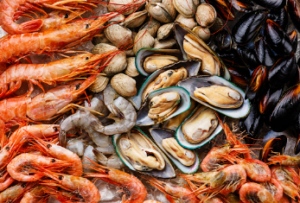Frozen Seafood: Frozen Seafood – How to Find Seasoned Frozen Seafood
Seafood that is frozen at the time of harvest can retain flavour and nutrients longer than seafood that has been thawed and refrozen. This process is often referred to as “flash freezing” and can be performed on board fishing vessels.
High-quality seasoned frozen seafood should not have freezer burn or excessive ice crystals on the packaging, and it should also be well-sealed and undamaged.
Look for a supplier with a good reputation.
 Frozen seafood is gaining popularity for a variety of reasons. When processed properly, it maintains terrific health benefits like omega-3 fatty acids and high-quality protein. Frozen seafood also offers a buffer against wild fluctuations in supply and can often be less expensive than fresh.
Frozen seafood is gaining popularity for a variety of reasons. When processed properly, it maintains terrific health benefits like omega-3 fatty acids and high-quality protein. Frozen seafood also offers a buffer against wild fluctuations in supply and can often be less expensive than fresh.
When a fish is flash-frozen shortly after being caught, it locks in the flavour and nutrients. It prevents spoilage and stops the degradation of proteins, vitamins and minerals that occurs with aging.
It is why a well-made, quality-controlled frozen fish product can rival that of its fresh counterpart. It’s important to purchase only high-quality frozen seafood from a reputable supplier and check the packaging for signs of freezer burn or other indications of poor handling.
Check their certifications and licenses.
Many of the seafood meals available at grocery stores are MSC-certified, which means that they’ve been sourced from sustainable fisheries and are helping to make our ocean more healthy for generations to come. Look for the blue MSC label when you’re shopping for seafood meals.
The best quality frozen seafood should have no freezer burn and minimal ice crystals on its well-sealed, undamaged packaging. In addition, the seafood should look fresh and not dried out or discoloured.
In fact, in a recent blind taste test, consumers found that the “fresh” fish they bought at the market was actually frozen and then defrosted to appear fresh for sale. It is why high-quality frozen seafood can often be as good as – or better than – fresh. When thawing frozen seafood, be sure to leave it out overnight in the refrigerator or use the defrost setting on your microwave. Avoid using warm water or leaving it at room temperature, as this can result in a mushy texture.
Look for a supplier who prioritizes sustainability
Seafood is a sustainable protein option, particularly when it’s sourced from environmentally responsible fisheries or responsibly managed aquaculture operations. However, seafood producers can also leave an environmental footprint through unsustainable business practices such as excessive waste and fossil fuel use.
Seafood consumers can help reduce this footprint by looking for high-quality frozen seafood that prioritizes sustainability. In fact, when frozen seafood is caught and subsequently processed at the peak of freshness, it can maintain its optimal texture and flavour and rival that of its fresh counterpart. It’s important to choose a supplier that uses rapid freezing methods that avoid large ice crystals, which degrade seafood quality.
Look for a supplier who offers competitive prices.
Seafood is a healthy addition to any diet, packing it with lean protein, vitamin D, minerals and essential fatty acids. Many prominent health organizations recommend making fish and shellfish a main staple of your diet, eating at least eight ounces a week. But, in a world of rising food prices and ever-changing grocery store deals, finding seafood on a budget can seem daunting.
Purchasing seasoned frozen seafood can be an economical solution to ensure your menu has access to heart-healthy proteins year-round. Frozen seafood is often less expensive than fresh seafood because it is harvested and frozen at its peak of freshness. This process not only protects the health of consumers but also saves money for retailers and fishermen alike.
When choosing a supplier for seasoned frozen seafood, look for a company that offers competitive prices and is committed to sustainable practices. They may be able to offer you more cost-effective options by purchasing larger volumes of seafood when supplies are high and then freezing them for later use.
When buying frozen seafood, make sure it is labelled “flash-frozen.” It means that the seafood was quickly frozen after harvest, which preserves its quality. It’s also important to look for packages that are vacuum sealed, as this will help prevent freezer burn. When cooking, you should only allow the frozen seafood to boil for a minute, as boiling it for longer can result in a tough texture and overcooked flavour.